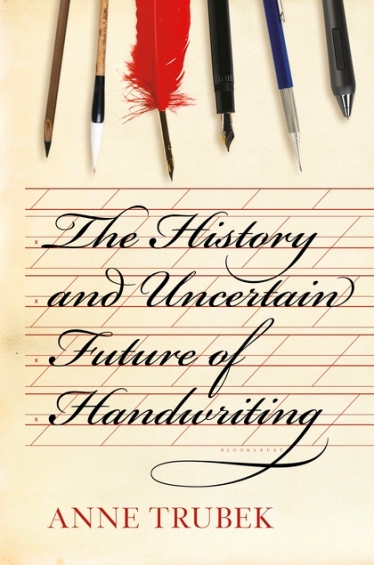This may come as a surprise, but a lot of people have strong feelings about handwriting. Ask a few friends, “should children be taught cursive at school?” and you’re bound to receive a variety of vigorous opinions. Anne Trubek, author of The History and Uncertain Future of Handwriting, may have learned this the hard way. In August of this year, just prior to the book’s publication, Trubek penned a New York Times op-ed piece headlined Handwriting Just Doesn’t Matter, and it received over one-hundred comments and letters. Almost all of these reader responses disagreed with Trubek’s call for schools to refocus handwriting education elsewhere, and one reader even went far enough to call keyboards “offensive tools.”

In some ways Trubek’s newly released book is a 154-page extension of that NYT op-ed, but it’s more aptly characterized as a simple history book. While she eventually gets around to discussing the digital age, Trubek fills most of the book’s pages by explaining the cultural evolution of writing, from early cuneiform and hieroglyphics to the common Palmer and D’Nealian cursive fonts that most of us use today. It covers a lot of the same ground as Paper by Mark Kurlansky, though Trubek’s narrower focus makes for a much quicker read.
When Trubek gets around to discussing the future of handwriting near the end of the book, it’s a lot less controversial than I’d expected given much of the ire it has created. Her argument boils down to this: writing’s role is changing in the digital age, as it has throughout history. Just as the printing press reduced the need for scribes, computers reduce our need for handwriting. It’s simply not as critical as it once was, and perhaps the time children spend learning handwriting could be reallocated toward something more useful (like computer skills). I’m unclear whether Trubek’s argument extends to learning basic, legible print handwriting – something which still has a lot of utility – but her main contention seems to be with cursive.
Trubek goes on to discuss the benefits of handwriting that are presented by its advocates, though she largely dismisses them as being cultural arguments. However, the cultural element of cursive is, in my opinion, the best reason for including it in a school curriculum. At least for the time being, cursive is still in use, and everyone would benefit from knowing the script to some extent. Though it should be pointed out that Trubek still envisions a place for cursive, at least as an art form, a hobby, or a tool for developing fine motor skills.
Whether you agree with Trubek’s main argument or not, anybody with a passionate opinion about this topic will be fascinated by the bulk of this book. The history lesson it contains is worthwhile, and the book is short enough to complete within a few sittings. And, who knows, after finishing the book you might be inclined to write the author a handwritten note in response.

This book was a waste of both time and money. Stupid design. Rather like buying a book about comparative architecture only to find there are no illustrations of buildings. Everything in this book is available form other sources. Nothing new here. She goes on and on attempting to describe the differences between uncials, Spencerian, and rustica but refuses to display any of the dozens of hands and styles. There are only 17 illustrations in the entire book: two are cuneiform (who cares?)and six are of people and a machine. Want to enjoy somethinga bout handwriting? Get “The Missing Ink” by Philip Hensher or “Script and Scribble” by Kitty Burns Florey.
LikeLike
More illustrations would have been good, but it didn’t bother me that there were so few. The book was more of a historical overview, as opposed to a detail-oriented text or workbook. And, yeah, everything in it is available from other sources… Again, it seems to be more of a popular-level historical overview, rather than a scholarly work of primary research.
Anyone looking for something with a lot of details or a scholarly textbook will have no use for this book. .
LikeLike